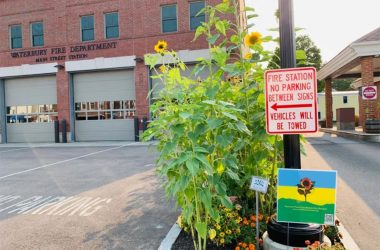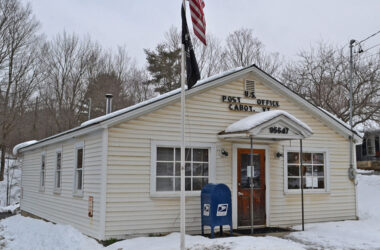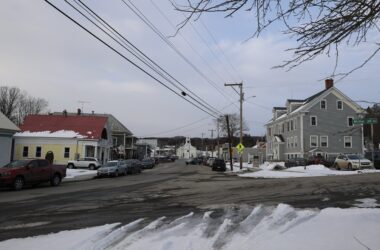CABOT – On February 11, Ellen Cairns, chair of the Cabot School Board, posted an invitation on the Front Porch Forum neighborhood network: “Come on down to chat with us and have a delicious cup of coffee on the house.”
Cairns wanted to talk to local residents about the Town Meeting Day ballot, which included a proposal for a 24 percent increase in the school budget and a question about whether to close Cabot high school; a recurring debate in town for the past decade.
Cairns committed to spending three mornings each week at Harry’s Hardware and The Den, a combination equipment retailer and restaurant that serves as a Cabot community hub, in the month leading up to the March 5 vote. Her purpose was to inform residents about the school-related proposals that would decide the fate of the small Cabot School system that currently serves 156 students in grades pre-K to 12.
“I was at the Den every single day, seven days in a row” in the week leading up to the vote, said Cairns, 61, whose day job is coordinator of teacher preparation programs at the Vermont Agency of Education. Chris Tormey, vice chair of the school board and school clerk, went door-to-door having similar conversations with residents, Cairns said.
Cairns said she believes the emphasis on communication between the school board and community members was a contributing factor in voters’ approval of the $4.5 million school budget by a 335 to 263 margin on Town Meeting Day.
Across the state, nearly a third of school district budgets with similarly steep increases failed to pass. And Cabot high school will remain open, at least for another year, with voters rejecting the proposal to close it by a 367 to 239 vote.

photo by Catherine Morrissey
Michael J. Hogan fields a question from a Cabot resident on Town Meeting Day, March 5.
Many Vermont schools faced dramatic increases in their proposed school budgets this year, partly due to state requirements for higher spending in areas such as special education and educator insurance.
Cabot’s budget included some additional costs, including an unexpected switch to oil heating after a malfunction of the wood-chip plant that was supplying the school’s heat. The school also plans renovations to move the elementary school, which is now spread between three satellite buildings, into the single structure where the high and middle schools are now. Those will shift into the outlying buildings.
Elizabeth Vitale, who has lived in Cabot for ten years, said she was worried the budget wouldn’t pass. “I was hearing about the budget increases and the history that we’ve had in Cabot with not passing our budgets.”
The budget is one concern of those who led the push to close the high school; the fourth time in 11 years that such a proposal has come up for a vote.
Cabot Citizens for School Choice crafted the petition in December to put the school closure question on the Town Meeting Day ballot this year. If it had passed, students and their families would have had to choose a high school outside of town. Cabot taxpayers would pay their tuition.
The petition intended to recognize “that the school is in financial trouble and that closure is on the horizon,” Citizens for School Choice wrote in an ad in the Cabot Chronicle before the vote. “The proposed budget is for a bare bones education at the Cabot School. As school budgets continue to rise, resources are shrinking, and so many school services are being cut.”
Vitale, who home schools her three children and joined Citizens for School Choice, cited Cabot School being challenged with, “everything from trying to be able to recruit and retain teachers to different parents expressing concerns over the education standards at school.”
One of Cairns’ biggest goals with her conversations before Town Meeting Day was explaining that closing the high school wouldn’t save taxpayers money. The Caledonia Central Supervisory Union, which Cabot School is part of, calculated that implementing school choice would add an estimated $300,000 to $500,000 to the upcoming year’s budget.
“A vote for school choice will increase taxes,” Cairns said. “That’s not my opinion, that’s a fact.”
Cairns said she also had problems with the timing of the closure proposal, which would have shuttered the school on June 30.
“It’s just too fast to pull the rug out from under current high school students,” she said. “One thing Cabot School does very very well is student voice and student choice, and this would not be that.”
Camryn Hoffman, 18, a Cabot high school senior who has attended the town’s school since preschool, said she enjoys the small community and project-based learning in her classes. She stayed at Cabot even when she had the option to attend the larger high school where her father works, at Champlain Valley Union High School in Hinesburg.
Hoffman is currently enrolled in a full course load of Community College of Vermont classes, which will give her college credit before she graduates this spring. Although she feels well-prepared by her education at Cabot, she said the recurring calls for closure have created a sense of instability for students.
“I feel like every student that’s gone through Cabot in the last 10 years has had that ‘should I stay at Cabot’ kind of feeling,” said Hoffman, “because who knows if it’s going to shut down.”
The petition to close the high school is “discouraging” for students, she added. “It feels like the town doesn’t appreciate the good work we’re doing, and they don’t think that we’re getting a good education,” said Hoffman, who has served as a student representative on the Cabot School Board. “It comes off as kind of like they’re thinking we’re not smart enough or that we could be smarter if we went to a different school, even if we’re proud of the work we’re doing here.”
While the high school will remain open, the debate continues. The town can consider a merger with another school, such as Twinfield, serving Marshfield and Plainfield, or the creation of a specialized project-based-learning academy to attract students from other Vermont districts.
In coming weeks, the school board plans to host more meetings with town residents. The board is discussing whether to hire a Vermont Rural Education Collaborative consultant who would be paid with discretionary funds that have already been approved as part of the budget, Cairns said.
She acknowledged that the continued debate can lead to a “self-fulfilling prophecy” for the high school: “Teachers leave, and then you have more turnover and more new teachers, and it’s harder to find qualified teachers, and the kids have to get used to new teachers when they’ve already built the relationships with the old teachers.”
To Cairns, however, the community discussion is crucial. She recalled one resident who “kind of came in hot,” during one of her coffee chats at the Den. The woman told Cairns she taught English at colleges across Vermont and said, in her experience, students from small schools like Cabot don’t perform as well as their classmates who attended larger schools. The woman suggested that Cabot high school merge with Twinfield.
The barista at the Den told Cairns that the exchange sounded “rough,” but the school board chair insisted she loved it.
Plenty of people pledged their support of the school, Cairns said. “But the people who I really enjoyed talking to were the ones who didn’t understand” or who told her, “I’m not in favor of keeping the high school open.”
Although Cairns disagreed that this was the year to implement a merger, she said she sees both pros and cons to the high school’s closure in the future. “I’m not fighting for anything at this point,” she said, “except that we keep having the conversations.”
Lucia McCallum reported this story on assignment from The Hardwick Gazette. The Community News Service is a program in which University of Vermont students work with professional editors to provide content for local news outlets at no cost.







